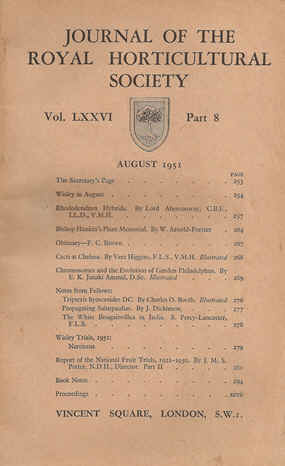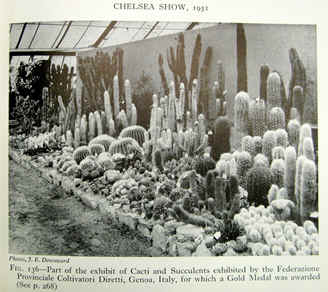Contents
of the Summer 2015 Northants News
|
1951
- A Landmark Year
Roland
Tebbenham
|
|
One
Friday I was browsing our local antique sale and I spotted a slightly
foxed issue of the Journal of the RHS, dated August-1951.
In those days the index was on the front cover and I saw that it
featured an article by Vera Higgins titled ‘Cacti at Chelsea’.
So I just had to buy it and I was not disappointed.
I contacted the RHS Lindley Library to request authority to publish
the picture of the exhibit and they kindly granted me permission and
supplied a better quality scan than I could manage on my equipment.
Hurrah for them!
1951
saw the ‘Festival of Britain’ emphasizing national recovery following
World War 2.
The RHS Chelsea Flower Show featured a single large marquée for
the first time in that year.
A number of smaller tents were replaced by the new 11,775sq.m
(2.9acre) ‘pavilion’.
Also a gigantic Himalayan garden was created there, made using 23
lorry-loads of plants from the RHS Garden at Wisley.
But what was special about the cactus exhibit that merited a piece
in the RHS Journal by an acknowledged expert on our favourite plants?
I can do no better than quote the author verbatim.
“A
very fine group of Cacti put up at Chelsea this year was so striking and
unusual that it caught the public imagination.
Tall columnar plants made a background for lower-growing, but still
large, specimens and along the front were the smaller Cacti and other
succulent plants.
The size of the Cacti was striking enough and the fact that so many
were in flower added to the attraction, while the English name that had
been bestowed on the great round spiny plants in the centre – the
Mother-in-law's Seat-took the popular fancy.
|

|
People
familiar with succulent plants appreciated the opportunity of seeing specimens
so much larger and more freely grown than those which are usually seen in this
country.
The Old Man Cactus, Cephalocereus
senilis,
is well-known to growers here but, near towns at all events, the abundant hair
is more often grey than snowy white, and specimens up to 3 feet in height are
most uncommon here.
Besides the excellent plants of Echinocactus
grusonii,
which had been so facetiously named, were large specimens of Ferocactus
stainesii
bearing a crown of orange flowers, whilst clumps of Cleistocactus
strausii
were flowering freely.
The great columns of Trichocereus
pasacana
were only surpassed by those of Cephalocereus
palmeri,
a wonderful blue colour with furry greyish wool along the edges and this also
bore flowers.
Amongst the smaller Cacti were some very floriferous Rebutias; these,
however, were grafted on Opuntia, a manner of growing not much in favour in this
country for plants which do well on their own roots, though suitable enough and,
indeed, essential for the propagation of cristates, of which a fine range was
shown.
Tall shrubby Euphorbias rivalled the columnar Cerei in the background and
some of the interesting smaller species were included, as well as flowering
Aloes and the colourful rosettes of Echeveria.
|

|
This
magnificent group was contributed by six nurserymen from Bordighera and
San Remo where, of course, the plants can be grown out of doors.
It can have been no easy task to transport this great load so far,
without damage, and the Italian nurserymen are to be congratulated on
their enterprise which won them a very well earned Gold Medal, and they
deserve our thanks for giving growers in this country an opportunity of
seeing so many fine plants.”
Vera
Higgins, F.L.S., V. M. H.
The
display at Chelsea was certainly arresting and merited its Gold Medal.
But 1951 was significant for another reason.
That is one for the members (past and present) of the NCSS
Northamptonshire Branch, as it was born in that year. |
Advertisements
were placed in the Northampton Chronicle and Echo and the Kettering Evening
Telegraph saying:
“A Northamptonshire Branch of the National Cactus and Succulent Society
is about to be formed.
The Inaugural Meeting will be held on Thursday 6th September,
at Ivy’s Café, Gold Street, Kettering at 7.30pm at which all those interested
will be made welcome.”
It
was to be the fiftieth branch of the society.
Michael Roan, an NCSS founder, was present together with twelve society
members and twelve visitors (six of whom enrolled) and a press reporter.
A committee was elected, a competition was held and the next meeting
arranged.
Thus began the journey of the branch with many developments,
vicissitudes, shows, sales events and memorable characters: ever changing to
meet the challenges of the moment.
We
should also remember that, after wartime privations, horticulture of all kinds
was a popular pastime in the 1950s and a national confidence was evident that
was reflected in the active membership of the two societies that thrived then,
the CSSGB and the NCSS.
Fusion of them resulted in the formation of the BCSS in 1983.
So do keep your eyes open at antique fairs – you never know what you
might find!
Roland
References:
‘RHSJ’
76(8) August-1951 p268 & fig-136
‘The
Northamptonshire Branch, Records and Reflections of the Early Years’ 1991,
BCSS Northamptonshire Branch


